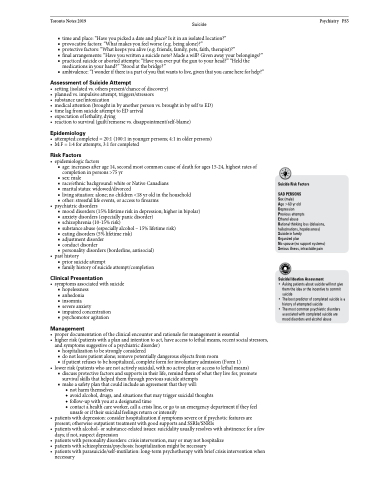Page 1169 - TNFlipTest
P. 1169
Toronto Notes 2019 Suicide
■ time and place: “Have you picked a date and place? Is it in an isolated location?”
■ provocative factors: “What makes you feel worse (e.g. being alone)?”
■ protective factors: “What keeps you alive (e.g. friends, family, pets, faith, therapist)?”
■ final arrangements: “Have you written a suicide note? Made a will? Given away your belongings?”
■ practiced suicide or aborted attempts: “Have you ever put the gun to your head?” “Held the
medications in your hand?” “Stood at the bridge?”
■ ambivalence:“Iwonderifthereisapartofyouthatwantstolive,giventhatyoucamehereforhelp?”
Assessment of Suicide Attempt
• setting(isolatedvs.otherspresent/chanceofdiscovery)
• plannedvs.impulsiveattempt,triggers/stressors
• substanceuse/intoxication
• medicalattention(broughtinbyanotherpersonvs.broughtinbyselftoED) • timelagfromsuicideattempttoEDarrival
• expectationoflethality,dying
• reactiontosurvival(guilt/remorsevs.disappointment/self-blame)
Epidemiology
• attempted:completed=20:1(100:1inyoungerpersons;4:1inolderpersons) • M:F=1:4forattempts,3:1forcompleted
Risk Factors
• epidemiologicfactors
■ age: increases after age 14, second most common cause of death for ages 15-24, highest rates of
completion in persons >75 yr
■ sex: male
■ race/ethnic background: white or Native Canadians
■ marital status: widowed/divorced
■ living situation: alone; no children <18 yr old in the household ■ other: stressful life events, or access to firearms
• psychiatricdisorders
■ mood disorders (15% lifetime risk in depression; higher in bipolar) ■ anxiety disorders (especially panic disorder)
■ schizophrenia(10-15%risk)
■ substance abuse (especially alcohol – 15% lifetime risk)
■ eating disorders (5% lifetime risk)
■ adjustment disorder
■ conduct disorder
■ personality disorders (borderline, antisocial)
• pasthistory
■ prior suicide attempt
■ family history of suicide attempt/completion
Clinical Presentation
• symptomsassociatedwithsuicide ■ hopelessness
■ anhedonia
■ insomnia
■ severe anxiety
■ impaired concentration ■ psychomotor agitation
Management
• properdocumentationoftheclinicalencounterandrationaleformanagementisessential
• higherrisk(patientswithaplanandintentiontoact,haveaccesstolethalmeans,recentsocialstressors,
and symptoms suggestive of a psychiatric disorder)
■ hospitalization to be strongly considered
■ do not leave patient alone; remove potentially dangerous objects from room
■ if patient refuses to be hospitalized, complete form for involuntary admission (Form 1)
• lowerrisk(patientswhoarenotactivelysuicidal,withnoactiveplanoraccesstolethalmeans)
■ discuss protective factors and supports in their life, remind them of what they live for, promote
survival skills that helped them through previous suicide attempts ■ make a safety plan that could include an agreement that they will:
◆ not harm themselves
◆ avoid alcohol, drugs, and situations that may trigger suicidal thoughts
◆ follow-up with you at a designated time
◆ contact a health care worker, call a crisis line, or go to an emergency department if they feel
unsafe or if their suicidal feelings return or intensify
• patientswithdepression:considerhospitalizationifsymptomssevereorifpsychoticfeaturesare
present; otherwise outpatient treatment with good supports and SSRIs/SNRIs
• patientswithalcohol-orsubstance-relatedissues:suicidalityusuallyresolveswithabstinenceforafew
days; if not, suspect depression
• patientswithpersonalitydisorders:crisisintervention,mayormaynothospitalize
• patientswithschizophrenia/psychosis:hospitalizationmightbenecessary
• patientswithparasuicide/self-mutilation:long-termpsychotherapywithbriefcrisisinterventionwhen
Psychiatry PS5
Suicide Risk Factors
SAD PERSONS
Sex (male)
Age >60 yr old
Depression
Previous attempts
Ethanol abuse
Rational thinking loss (delusions, hallucinations, hopelessness) Suicide in family
Organized plan
No spouse (no support systems) Serious illness, intractable pain
Suicidal Ideation Assessment
• Asking patients about suicide will not give them the idea or the incentive to commit suicide
• The best predictor of completed suicide is a history of attempted suicide
• The most common psychiatric disorders associated with completed suicide are mood disorders and alcohol abuse
necessary


